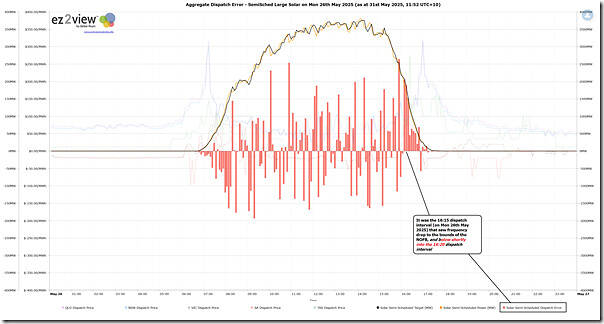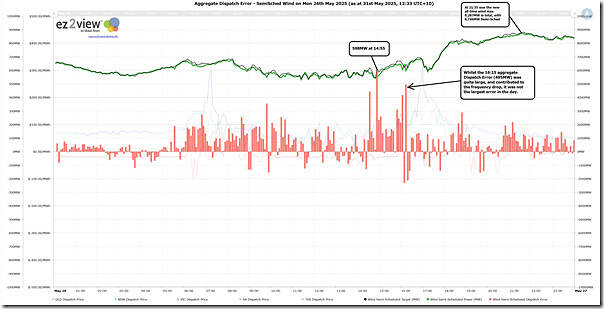Earlier on the week we saw this ‘Drop in mainland system frequency on 26 May 2025’ (briefly down outside of the NOFB) … which appears to have been in large part due to ‘Poor dispatch performance of VRE (collectively) on Monday 26th May 2025 sufficiently large to drive frequency outside of NOFB’.
… as a bit of a detour, already this morning we’ve taken ‘a quick look at system frequency, with 2 x coal units offline overnight into Saturday 31st May 2025’.
So let’s now return to Monday 26th May 2025 to take the next step into our analytical journey, with respect to aggregate ‘Dispatch Error’ across both Semi-Scheduled fuel types (which were the ones with the biggest and most damaging deviations in the 16:15 dispatch interval).
Trended aggregate Dispatch Error through the day for (Semi-Scheduled) Solar
We’ll start with the Large Solar units … the Semi-Scheduled ones only, as the Non-Scheduled units are more invisible:
1) not needing to provide Availability,
2) or receive (or even loosely follow) Targets.
Here’s a trend through the 24-hour period on the day for NEM-wide aggregates:
To me there are four time periods that jump out through the day:
1) Overnight – on this occasion thankfully no ‘lunar megawatts’ visible
2) Morning ramp – during this morning period:
(a) Particularly a ~2 hour period early;
(b) We see a consistently negative ‘Dispatch Error’:
i. Which comes from Output being consistently above Target;
ii. Which can be understood due to the underlying challenges in forecasting VRE, and the common use of a ‘persistence’ style forecasting method (inside of ASEFS and/or in the unit self-forecast)
3) Middle of the Day – during this period the deviations yo-yo positive and negative:
(a) Being as large as 250MW
(b) Or just below 10% (of aggregate Target) at times during the middle of the day.
4) Evening ramp – during this late afternoon and evening period:
(a) Particularly a ~2 hour period early;
(b) We see a consistently positive ‘Dispatch Error’:
i. Which comes from Output being consistently below Target (i.e. the inverse of the morning ramp);
ii. Which can be understood due to the underlying challenges in forecasting VRE, and the common use of a ‘persistence’ style forecasting method (inside of ASEFS and/or in the unit self-forecast)
(c) The frequency drop just after 16:15 features in this ‘evening ramp’ on this particular day.
Trended aggregate Dispatch Error through the day for (Semi-Scheduled) Wind
Moving onto the Wind units (and remembering that this was a very windy day, including a new record for instantaneous production level) we see the following:
Even aside from the obvious ‘sun doesn’t shine at night’ difference to the trend above for Large Solar, there are some obvious differences here:
1) First and foremost on this (very windy) day:
(a) there are almost three times the number of dispatch intervals (72%) with underperformance compared to Target compared to overperformance (28%);
(b) Coupled with this, the deviations of underperformance are much larger in absolute terms than overperformance
(c) The deviations are also larger in absolute terms compared to solar (and slightly higher in relative terms … up to 10%)
2) There are several long contiguous blocks of time where Target was consistently higher than actual output (FinalMW).
(a) Such as 25 straight dispatch intervals to 02:20
(b) Such as 17 straight dispatch intervals to 07:15
(c) Such as 20 straight dispatch intervals to 16:05 …
i. Including 598MW at 14:55
ii. And including 417MW at 16:05
… each period of which would have been a sustained drag pulling frequency lower.




Leave a comment